Sandra Gulland's Blog, page 33
July 14, 2011
Becoming my own publisher
I've worked in the publishing realm for nearly 40 years (ouch!) and the modest e-book publishing venture I'm undertaking now is a sweet little thrill. I've always wanted my own "press." (And a bookstore … but that's another matter.)
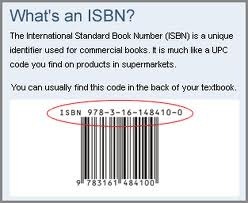
I just registered to get my own ISBN numbers. I know, that's not the type of thing that would excite most people. Call me weird, but it makes me just a little giddy.
Not that it isn't without its headaches. I was told I could order 10 ISBNs for $250 U.S. at www.MyIdentifiers.com.

Yes, indeed, but not if you are in Canada. After a Google search and several annoying bumps from one site to another, I discovered that Canadians must first register with CISS (pronounced kiss). These ISBNs, I gather, will be free.
I eagerly await acceptance. I hope they're not on summer holiday. I hope I get them before I go "to press."
July 12, 2011
On writing, revision, deadlines, balancing & teaching: a chat with author & dynamo Genni Gunn
Last month I had the opportunity to ask author/dynamo Genni Gunn a question I've long been pondering: How does she do it? She's a writer of literary fiction, a teacher, singer, musician and translator. I think you get the picture.
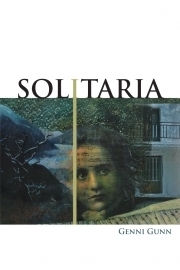
Genni has just published her latest novel, Solitaria, with Signature Editions. As "Author of the Month" she was available for an on-line dialogue—so I pounced. I found what she had to say both inspiring and enlightening.
How do you balance writing, teaching and all the other things you do? In short: how DO you do it?
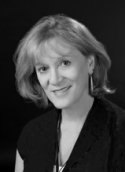
First of all, for context, let me say that I am the type of person who could never do one thing only. No matter how much I protest (weakly) that I have too much to do, the fact is that I thrive on activity and challenge. So I am constantly taking on new ventures, thinking up new projects, saying yes to everything, and then figuring out how to do it all.
So, that said, how do I balance it all?
My main activities are writing (and this entails a variety of projects and genres), teaching creative writing, manuscript evaluation and editing, and various other interests and pursuits which include lectures, readings, consulting, and promotional tours. I tend to think of these activities as falling into three categories: 1) the writing; 2) the teaching; and 3) everything else. Two of these categories are linked to time slots, which themselves create a good balance: September to December, I teach creative writing half-time at Kwantlen Polytechnic University, and January to September, I consider my writing months. Of course, there's a whole life and a lot of travel to fit into those same twelve months.
In practical terms: during my four-month semester, I devote all my energy to teaching. I have a full load – four courses – and that pretty well takes up all my head space. However, I usually find time to do peripheral activities while I'm teaching. For example, I might evaluate a couple of manuscripts, give readings, or help fundraise for a writerly cause. I don't try to write, because I want to have all my energies fresh for students who I very much enjoy teaching and mentoring.
During the rest of the year, which I consider my writing time, I have to really discipline myself to remain sitting at my desk. When working on a novel, I give myself a three-page a day minimum, and this works very well for me. Once I'm done my three pages, I can go do something else. Meantime, three pages a day, five days a week for, say, six months (notice I've realistically reduced the writing period by two months) would produce three-hundred and sixty pages of something that might approximate a draft. I consider reading and research part of my writing day, and if I have nothing to write, I still sit at my desk and read and research and make notes (at least three pages of them).
Of course, I rarely focus only on one writing project (unless I'm at the editing stage). I might be writing a novel, but I'm also fitting in a story here, a couple of poems there, a travel piece, and a lot of research about everything.
The main thing I DO, I think, is to prioritize everything – often with lists that I take great pleasure ripping up when complete. That way, everything gets done when it's due. What works for me is to focus on something for many hours at a stretch. I can easily work from 7:00 a.m. to 5:00 p.m. if I'm engaged in something. I don't like to leave things unfinished. I have an intuitive sense about how long a project will take – and this is simply experience, I'm sure – so I complete projects to deadlines.
(Don't you love that word "deadline"? It's either 'a guideline on the bed of a printing press, beyond which text will not print'; or a line drawn around a military prison during the Civil War, beyond which soldiers were authorized to shoot escaping prisoners.)
When I think of deadlines, I prefer the implied threat of the latter, though text that will not print is almost as intimidating. And if I don't have a deadline, I draw one, so that nothing will escape.
I've always wondered about the origin of the word deadline. How perfectly apt.
I find setting so many words-per-day forward works well for a first draft, for me, but I flounder, a bit, on the many revisions. Do you have a way to measure (and check off) revised pages?
Also, do you aim to have a draft in a put-aside state before your teaching break? I imagine that that break works well in terms of getting perspective on the draft.
I wish I could tell you that I have an organized method to get to the revisions, but I don't. Generally, though, I find the first draft is the hardest to get through from beginning to end. Once I have that, I tend to work systematically for the next draft. I will do a variety of passes for different things. So, for example, in the early stages, I might concentrate only on structure. In Solitaria, at one point, I deconstructed the entire novel into scenes, then reassembled them in a new order, with a new focus in mind. Once structure is in place, I will do a re-read, and mark as I go where I need to add scenes, expand on scenes, or deepen character, etc. Then I go about doing each of those things until I have a new draft. Then I re-read again, looking for something else, perhaps to thicken the setting, keeping in mind the metaphoric properties of it, etc. So it really is a process that evolves as I go. I do find, however, that once I've got that first draft, the real work begins, and the real play too. This is the part I love.
Re the second question: I do aim to have a draft in a put-aside state, because you're quite right, reading that draft four months later really does give me a clean perspective.
I imagine you must have an interesting process too, given all the impeccable historical research in your work.
I love the idea of going through a draft with one thing in mind, Genni.
I reread with pencil in hand, make the revisions on computer, reread/edit again, make the revisions again, over and over (and over!) again. It's like clearing rocks from a field: with every two rocks I take away, another one comes up. Eventually, I'm not making so many edits when I read it through.
I'm amazed by your deconstruction/reconstruction of your last novel.
What do you start with? Do you outline? For the novel I'm writing now, I was determined not to take 8 years, so I started with a scene by scene "outline" (@ From Where you Dream, by Robert Olen Butler). It was a big help getting through the first draft, but it's still taking me years. I don't think there's any way around it.
What a great metaphor, about clearing the rocks from a field, especially given that in Solitaria, that's what the father does day in and day out. It's that part of Italy where rocks are constantly surfacing in fields, and need to be cleared (I thought I'd read somewhere that these rocks floated to the surface – an image I really love – but now I can't find any documentation to back this). Nevertheless, yes, that's exactly what we do in revisions!
As to the actual process – outline or not? – what I've found is that despite the fact that I think it will be easier with each novel, it actually isn't. My sense is that each story requires a different method. So what worked in one, won't necessarily work in another.
I tend to begin with an idea – so I know what the point of the novel is when I begin writing. I also know the ending of the novel, not the particulars of plot, but the general large, what-am-I-trying-to-say kind of ending. So, for example, in choosing the theme of abandonment (as I did in Tracing Iris), I wanted to explore the effects of abandonment on memory and our perception of ourselves. That wasn't going to make a story, obviously, because it was an abstract idea. However, I thought about it for a long time, then I did a lot of research around the topic of not only abandonment, but extinction and survival – which seemed very related to me. Eventually, a story emerged that could carry my exploration.
At a certain point in the process, I do make a very broad outline – I think of it as a map of the novel's journey. This map has a final destination marked on it, and whatever stops-of-interest (scenes) I have already conceived along the way. And once I begin writing, this map grows and changes, though the final destination remains the same – and by this, I only mean in the idea of it, not in the way it arrives at the ending.
Sometimes I even draw my map on graph paper, to give me a visual sense. I might assign each character a different coloured pen, and see how the character orchestration is working. This was a trick I learned while writing the opera libretto, because you can't bring someone onstage and have them just stand there without doing anything; as well, you can't hire a singer for a huge sum of money, and then have that singer offstage for half the opera. So character orchestration is a very vivid, vibrant thing in live theatre, and I see no reason why it shouldn't be in novels too.
Ah, that rocky realm. We actually live in such a place. I adore the image of the rocks floating to the surface.
I know it's often said that writing never gets easier, but something in me refuses to give up hope. I'm now at that familiar point: "This Is Too Hard, It Will Never Work, I Should Give Up Writing Novels." You know? (Perseverance!)
I think you're right, each story requires a different approach. If only the story would tell us.
I like your map concept, and especially the coloured pen graphs. I just took a character out, and doing so brought another into vivid focus. My current cast is far, far too big—a problem with historically-based fiction.
How do you guide your students to revise?
I know those moments too well, yet I also know that they're necessary to keep me revising and re-envisioning until everything feels just right.
Regarding revisions for students: this is tougher to do with the first-and second-year students, who are madly in love with their own words. But we do workshop in class, and they're required to revise, although some do only a light edit. The third-and fourth-year students, however, are very keen to revise. I bring in lots of material on revision to help them re-envision their work. One of the things I've been doing with the upper grades is an interesting exercise in focus. We take one page of each of their stories (I make copies for everyone), then we go sentence by sentence, or paragraph by paragraph to see what we can remove and still keep the sense, mood, style, etc. In other words, what can we remove that is unnecessary? This produces hilarious results – sometimes a whole page is distilled into one sentence. Other times, the writing suddenly intensifies. At best, what this exercise does is to make young writers aware of the actual language, the sentence construction, the unnecessary words we use in speech, etc. In the end, students revise at their own rate. I often think about how we have writing courses that span three or four months, yet the absorption rate for this kind of learning is much much longer. It's one thing to understand something intellectually, and another to actually be able to apply it.
This has been a great conversation. Thank you so much!

Be sure to read Solitaria—I'm reading it now and enjoying it very much. Here's the wonderful book trailer to tempt you:
July 10, 2011
Ta da! The euphoria of finishing a draft
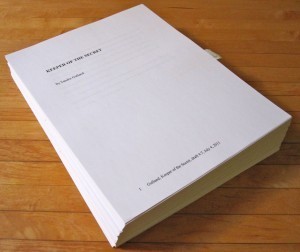
The euphoria of finishing a draft is intoxicating! There's nothing quite like it.
The pages are neatly printed out and stacked. I feel like I've just come up for air, gasping from being so long under water.
As always, there was blood, sweat and sleepless nights leading up to the finish.
I forget that this is true of each finish, each stage of the writing process (outline, first draft, second, third … sixth).
Steel is forged by fire: a series of deadlines helps heat things up. An approaching long holiday can act as an effective motivation to finish. The most definitive deadlines are the ones when I have to give a manuscript to an agent or editor. A literary competition could work, as well.
Like preparing for a final exam, an athletic event or a recital, such deadlines force me to give it everything I've got. Again and again and again.
And so, here it is: the 4th draft of The Next Novel! There will be a 5th and a 6th, no doubt, before my publisher even sees it (and then likely there will be a 7th and an 8th, as well). The 8th will likely be the "downhill draft"—the polishing and fiddling. That's always such a pleasure.
But right now, it's still heavy lifting. For this 4th, the changes were major: a switch from 3rd to 1st person point-of-view, a major character eliminated, new scenes in, old scenes out. (The manuscript is 90,000 words, and the cut file is 60,000!) It's possible that the 5th will be a significant re-vision as well.
But for now, it's all all packaged up and ready to go to Fiona Foster—reader, writer, editor, reviewer, wise woman.
I feel like I'm on holiday—until I look at the wreckage of my office, the weeds in the garden, the overflowing in-box. Even so, I tackle them with euphoria.
How do you set deadlines for yourself?
July 2, 2011
The challenges of writing a sequel, prequel, interquel or paraquel
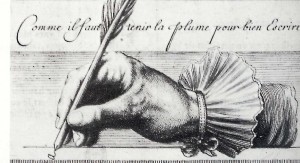
One of my readers sends me facinating questions. Here is the latest:
How are you going to deal with the fact that you wrote about most of these characters in your last book? Do they have the same personalities they did previously, as they would in a proper sequel, like Tales of Passion, Tales of Woe? Or do you look at this as a completely different novel, and, as such, a fresh break from the previous book's tone, point of view and characterizations?
The Sun Court novels are "paraquels": they take place roughly in the same place, at the same time, and involve many of the same characters. In some instances, they share the same scenes, although from different perspectives.
In some respects, they pose more of a challenge for me than the Josephine B. Trilogy. For the Trilogy, the cast of characters changed dramatically from one novel to the next, and the novels were sequential. The characters that remained the same throughout matured and changed.
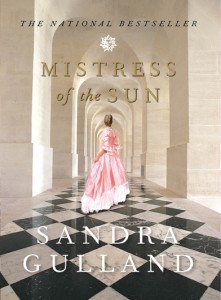
For the novel I'm writing now, I'm already regretting a few of the sentences in Mistress of the Sun. (In fact, I may revise a scene or two when I bring Mistress out in ebook under Sandra Gulalnd Ink.)
I know more now about what happened, for one thing. That's inevitable—but also, the story itself demands certain changes.
I decided early on to be true to the story, even if it contradicted some of the things that happened in Mistress. The problem scenes are brief—merely a sentence or two; I might award readers who are tenatious enough to discover the disconnect!
I'm not sure how I'd confront these questions if I were in your shoes, but I actually think it's a great problem to have. Revisiting the same universe in different novels creates quite a rich tapestry from which an author can draw — not only because of the density of characters and stories that build up, but because of the possibility of added layers of meaning.
Thank you so much for this observation—so true.
Some of The Next Novel explores the world of 17th century theatre, a world away from the Court, so there is added perspective on that period, a layering on of perspectives: a rich tapestry, as you say.

On the work front, I'm just about finished changing The Next Novel from 3rd person to 1st. It has taken me three days! I'm looking forward to reading it through. In a week I'm going to be sending it to another of my very best readers, the wonderful editor and writer Fiona Foster.
In terms of Sandra Gulland Ink, my e-book publishing venture, I've found someone (though elance.com) in Romania to retype and format my Trilogy. I hope that that process will be finished this month.
I will then have to reread and proof the Trilogy files—which works out perfectly, as it turns out, because I'm going to France in September to be interviewed on film for a documentary about Josephine. (More on that to come.) I've been away from Josephine's world for well over a decade; I'm looking forward to returning.
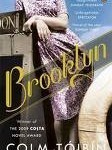
My holiday reading this wonderful summer long weekend is Brooklyn by Colm Toibin. What's yours?
June 27, 2011
Doing the work
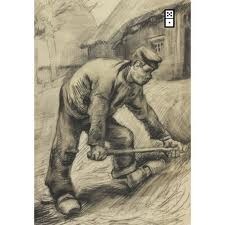
I've been working hard on the revision of The Next Novel, combing out tangles—only to have new tangles emerge. There's something at the heart of this novel that eludes me, and the more I stare at it, the more mysterious it seems.
When I get to this desperate stage, I gobble up books on writing. I must have almost one hundred now, for when I hit this wall only a new book on writing will do.
My bibles now:
The Breakout Novelist by Donald Maass.

I actually think this might well be the only book I'll ever need, it's so good. Maass, a NY agent, is extremely articulate on what makes a novel work. I usually ignore the writing exercises in books on writing, but these I like (and am using).
But of course, I had to get just one more book on writing, and it proved to be essential as well:
Do the Work, by Steven Pressfield (cover at the head of this post), is very short but powerful: a one-two punch on the creative process, a tremendously bracing Hang In There diatribe—just what I needed.
Someday I intend to put my short-list of fantastic books on writing on a spearate page on this blog.
But for now, I'd like to know which books you recommend.
(Other than From Where We Dream by Robert Olen Butler, which we all know is great.)
June 16, 2011
New French edition of Mistress of the Sun: un livre vraiment beau!
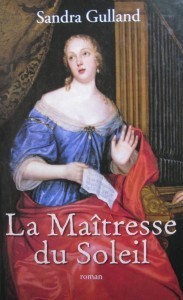
I'm very pleased with the design of a new French edition of La Maîtresse du Soleil—Mistress of the Sun—published by Éditions France Loisirs (through my Québec publisher Hurtubise). It even has a red ribbon marker.
The designer has used one of my favourite paintings of Louise, with her two children and an angel.

Some time ago, I read who the model for the angel was. I vividly remember thinking Wow!—but can I find that information now? No! If anyone knows, I'd be grateful.
You may buy this edition on-line here or here.

In other news, I'm working hard on an edit of The Next Novel: this will be the 4th draft. Quite a few changes: one character out, another radically changed. It is inching along.
I'm also making arrangements for my trip to the Sunshine Coast Festival of the Literary Arts in British Columbia in August.
And working to further Sandra Gulland Ink, my e-book publishing venture. Very exciting.
{Painting: Louise de La Vallière and her children by the 17th century Dutch painter Peter Lely. It's curious for him to have chosen Louise as a subject: he was living in England, and was Charles II's principle painter.}
May 31, 2011
The importance of getting out
[image error]
{Photo by Jane Paul of me and my "twin" look-alike, Janette Reynolds. Janette had been to my reading in Calgary a few years before.}
Writing a novel is such a long and solitary labour, it's wonderful to get out and meet readers. I'm chuffed!
Plus: I learned how Petite (and Athénaïs, for that matter) likely disguised their pregnancies. Also, in a talk with another reader, I got the germ of an idea on how to possibly revise the beginning of Mistress of the Sun.
Yes, one never stops!
May 24, 2011
May I quote you?

I love this email:
"Just finished Josephine B. Trilogy. Best. Book. Ever. Couldn't tear myself away and practically wept when I finished it. Thanks for a tremendous read."
Thank you, Pat. It's quite special when a reader takes the time to 1) figure out how to write to me, and 2) write. It means a lot.

A quick run-down of the day:
1) Revising The Novel. This morning I had a very helpful email from a friend, Lucy King, about Asperger Syndrome. One of my characters, the brother of my heroine, is developing in this direction. Interesting.
2) Picking out paintings for the e-book edition covers (of my own publishing venture). It's trickier than I thought it would be. Finding works in the public domaine is the trick, and then getting high-resolution images. I think I've got it; I hope they suit.
Of course image research is the most delicious diversion there is. I've discovered so much: one, this painting by Andrea Appiani that's thought to be of Josephine:
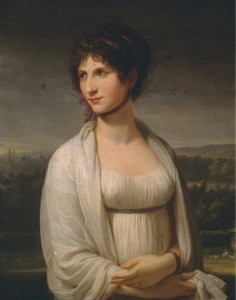
I was sceptical, at first, but now, after comparing the face in this portrait to other portraits of her, I'm inclined to think that it just might be. Alas, it's unlikely that I can get permission to use it on a book cover.
3) Worrying about not being prepared for my two readings and one dinner speech this weekend in Banff, so I've decided that I really do need to put The Novel aside tomorrow and attend to this. I'm excited about using PowerPoint, but I'm a little nervous about it as well: I've never given a PowerPoint presentation before.
Ciao!
May 18, 2011
E-books: feast or famine for writers?
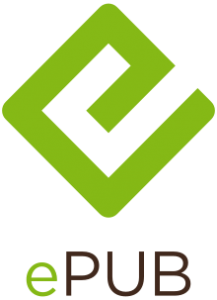
I've been watching the e-book revolution with astonishment. Everything is changing so quickly. There's no doubt that the times they are a'changing. In our house, most of the books we buy now are digital, and in the U.S., I'm selling more e-books than print. This is apt only to escalate.
On March 22, less than two months ago, Barry Eisler turned down half a million dollars from Minotaur Books in order to self-publish. On the same day, it was announced that Amanda Hocking did the exact opposite, turning away from the millions she's earned self-publishing in order to be published by a big New York publisher.
"It is crazy that we live in a time that I have to justify taking a seven-figure publishing deal with St. Martin's. Ten years ago, nobody would question this. Now everybody is." — Amanda Hocking
I think what stirred the most were the revelations of Amanda Hocking's "numbers": in January of this year, self-publishing, she sold 450,000 books. In one month.
"Many of the folks who hit the pre-digital New York Times hardcover list did not have 450,000 book sales in a single year. Granted, Hocking's books are mostly digital and they're cheap (99 cents to $2.99), but still. These are significant game-changing numbers . . . " —Kristine Kathryn Rusch, Beginning Writers Again—Sort Of (Changing Times Part 17)
Right now, given what has become "standard" contract terms, the publishers are doing well and the authors are not. Imagine an e-book that sells for $10 in the U.S. In current e-book practice, the publisher earns $5.25 on the sale of that book, and the author $1.75. If the author self-published the book, he or she would earn $7.00. Needless to say, this has caught the attention of the writing community.
"The stories coming out of the trenches right now are incredible. … If there are e-book failure stories floating around out there, we have yet to hear them." —January Magazine, Authors on Self-publishing E-Books
It isn't all about money; not everyone is in a niche that will rake in millions. It's also about that oh-so-70s word: empowerment. Suddenly, one can publish rather easily. Suddenly, there is no such thing as OPP (out of print). Suddenly, there is no such thing as out of stock.
I'm now in the process of looking into to publishing my books as e-books in those countries where I own the copyright. It would be an investment of both time and money, and I wouldn't expect to clear for a few years, but even so, the thought is making me giddy. Before, I felt everything was up to others; now I can do it myself.
What are your thoughts? Are you reading digitally?

Here are some links if you wish to explore this new world yourself:
E-Book Royalty Math: The House Always Wins | Our Blog
Self-Published Author Amanda Hocking Makes Millions From eBook
This 26-Year-Old Is Making Millions Cutting Out Traditional Publishers With Amazon Kindle
May 17, 2011
Yet another shout out for Baggot • Asher • Bode
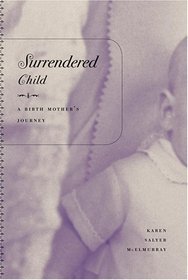
I've mentioned here before how much I enjoy Bridget Asher's blog. I want to live in her world. You'll understand why: here.
Bridget is the author of The Province Cure for the Broken Hearted, a charming, heart-felt novel I loved. I interviewed her earlier on this blog, throwing back at her her own charming "1/2 dozen" questions that she uses in her own author interviews.
Well, apparently she also offers authors the "Alternate Brutal Variety," should they choose. Only a certain type of brave soul would go there, for indeed, these question hit below the belt. Karen Salyer McElmurry, author of Surrendered Child (shown above), fits the bill. You'll find her answers to the Alternate Brutal here.
I love this from Karen:
I'm a literary writer. If my family failed to get this picture—tattooed, former hippy, misplaced mystic—the image of me as a writer with a small audience is hard for them, and sometimes for me. I am a graven image in my own heart, some days.
She also quotes from the book Art and Fear by David Bayles, a book I read some time ago, and which resonated.
He says this: "the function of the overwhelming majority of your artwork is simply to teach you how to make the small fraction of your artwork that soars."
How true.

Right now on my desk:
• revising the 4th draft (taking a character out, clarifying my central character: her desires, her challenges);
• preparing for a trip to Banff in a week and a half to the Banff Book Discussion Weekend in Alberta—a speech and two readings to prepare, as well as a power point presentation (a first: I apparently like backing myself into things);
• setting in motion an ebook publishing venture of my own (really quite exciting);
• preparation for a family, friend & business trip to N.Y. only a few days after I return from Banff—visit son and his girlfriend, meet with my publisher, hang out with old best friends I haven't seen in years.
Plus a wonderful family weekend coming up!
Yes: lots.



